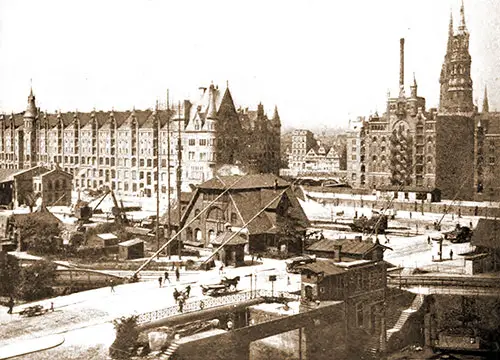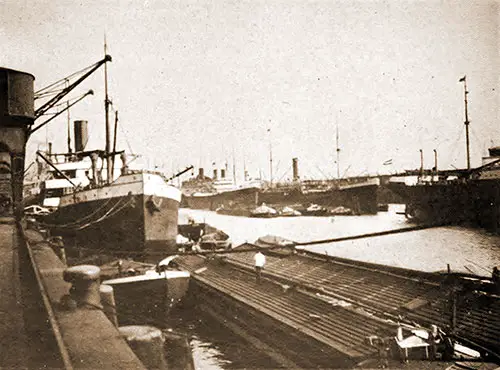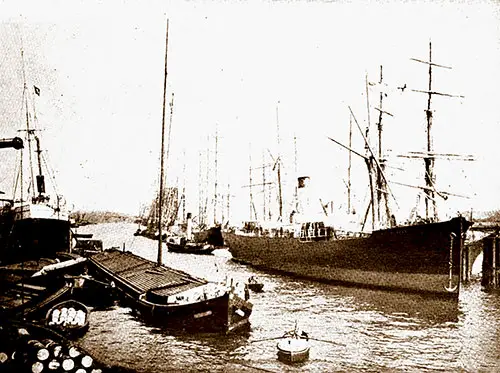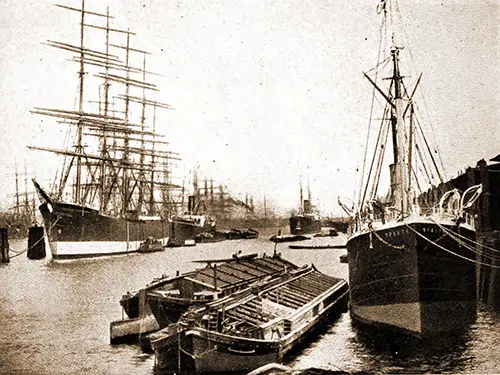Hamburg Passenger Lists – 1881-1952

View of a Portion of the Free Port of Hamburg ca. 1912. GGA Image ID # 1755d2cb84
Hamburg is a major transport hub in Northern Germany and is one of the most affluent cities in Europe. Hamburg became a city-state within the North German Confederation (1866–71), the German Empire (1871–1918) and during the period of the Weimar Republic (1919–33).
The entrance to the port is affected by utilizing the Elbe River. A vessel approaching the mouth of the river will first sight, in order, the four light vessels, Elbe I or outer light vessel, Elbe II, Elbe III, and Elbe IV, all of which are painted red with their names on their sides. These lights indicate the channel between the Scharhorn Riff, Neuwerker Watt, Kleiner Vogelsang, and Steilsand on the south side of the entrance and the Grosser Vogel, Gelbsand, and Hakensand on the north side.
The river, which almost forms a figure S between Cuxhaven and Hamburg, is easy to navigate. The channel is well marked with the uniform German system of red spar buoys with letters on the starboard and black conical buoys with numbers on the port.
Between the sea and Cuxhaven, the river has a navigable depth of about 37 feet at high water neap tides and about 26 feet at low water spring tides. Between Cuxhaven and Hamburg, the minimum depth is 25 1/2 feet at low-water spring tides, rising from 7 1/2 to 11 feet. The channel is now being deepened to 40 feet at mean high water. The width of the channel ranges from 660 to 1,300 feet.
The maintenance of the river was under the German government's control, which relieved the port of Hamburg of that responsibility in 1921 after the port had spent approximately $40,000,000 on improvements.

Another Busy Scene at the Hamburg Docks ca. Early 1900s. GGA Image ID # 17566841a5
Note: Typically, only the origination and final destination ports are listed in each link. Other intermediary ports of call are not listed.
Hamburg American Line / Hamburg Amerika Linie (HAPAG)
Hamburg American Line / Hamburg Amerika Linie (HAPAG)
Return to Quick Links to Decades
Hamburg American Line / Hamburg Amerika Linie (HAPAG)
- 1900-08-09 SS Fürst Bismarck - Hamburg to New York
- 1900-10-07 SS Patricia - Hamburg to New York
- 1901-07-28 SS Pretoria - Hamburg to New York
- 1902-04-22 SS Pennsylvania - New York to Hamburg
- 1902-06-21 SS Pennsylvania - Hamburg to New York
- 1903-08-22 SS Pretoria - Hamburg to New York
- 1903-08-27 SS Fürst Bismarck - Hamburg to New York
- 1905-07-29 SS Graf Waldersee - Hamburg to New York
- 1905-09-14 SS Hamburg - Hamburg to New York
- 1905-11-11 SS Pennsylvania - Hamburg to New York
- 1906-08-04 SS Pennsylvania - Hamburg to New York
- 1907-05-04 SS Meteor - Genoa to Hamburg
- 1907-06-01 SS Batavia - New York to Hamburg
- 1907-08-08 SS Amerika - Hamburg to New York
- 1908-11-12 SS Amerika - Hamburg to New York
- 1909-10-07 SS Deutschland - Hamburg to New York
Return to Quick Links to Decades
Hamburg American Line / Hamburg Amerika Linie (HAPAG)
- 1910-06-30 SS Cincinnati - Hamburg to New York
- 1910-07-24 SS President Lincoln - Hamburg to New York
- 1910-09-08 SS Cincinnati - Hamburg to New York
- 1911-05-24 SS Graf Waldersee - Philadelphia to Hamburg
- 1912-08-03 SS Cincinnati - Hamburg to New York
- 1912-09-28 SS Patricia - Hamburg to New York
- 1912-11-01 SS President Lincoln - Hamburg to New York
- 1913-10-25 SS Pretoria - Hamburg to New York
- 1914-03-11 SS Imperator - Hamburg to New York
Nordenfjeldske Dampskibsselskap
Return to Quick Links to Decades
American Line
Canadian Pacific Line
Hamburg American Line / Hamburg Amerika Linie (HAPAG)
- 1926-01-28 SS Albert Ballin - Hamburg to New York
- 1926-07-30 SS Deutschland - Hamburg to New York
- 1926-08-18 SS Westphalia - Hamburg to Boston and New York
- 1926-08-27 SS Albert Ballin - Hamburg to New York
- 1926-12-10 SS Cleveland - Hamburg to New York
- 1927-07-06 SS Albert Ballin - New York to Hamburg
- 1927-07-30 SS Reliance - Hamburg to New York
- 1927-08-12 SS Deutschland - Hamburg to New York
- 1927-08-16 SS Resolute - Hamburg to New York
- 1927-09-14 SS Thuringia - Hamburg to New York
- 1927-09-23 SS Deutschland - Hamburg to New York
- 1928-10-12 SS Deutschland - Hamburg to New York
- 1929-01-16 SS New York - Hamburg to New York
- 1929-03-15 SS Hamburg - Hamburg to New York
- 1929-04-05 SS New York - Hamburg to New York
- 1929-04-19 SS Hamburg - Hamburg to New York
- 1929-10-17 SS Cleveland - Hamburg to Boston and New York
Royal Mail Steam Packet Company (R.M.S.P.)
- 1921-10-22 SS Orbita - Hamburg to New York
- 1922-03-31 SS Orbita - New York to Hamburg
- 1923-03-27 SS Orduña - Hamburg to Bermuda and New York
- 1923-08-01 SS Orbita - Hamburg to New York
- 1923-08-29 SS Ohio - Hamburg to New York
- 1923-12-19 SS Orca - Hamburg to New York
- 1924-07-06 SS Orca - Hamburg to Québec and New York
- 1924-07-22 SS Ohio - Hamburg to New York
- 1924-07-29 SS Orbita - Hamburg to New York
- 1924-10-08 SS Orbita - Hamburg to New York
United American Lines (Harriman Line)
- 1922-09-05 SS Resolute - Hamburg to New York
- 1922-11-15 SS Reliance - Hamburg to New York
- 1923-07-10 SS Reliance - Hamburg for New York
- 1923-07-24 SS Resolute - Hamburg to New York
- 1923-10-21 SS Cleveland - Hamburg to New York
- 1925-05-08 SS Cleveland - Hamburg to New York
- 1925-05-19 SS Resolute - Hamburg to New York
- 1925-06-30 SS Resolute - New York to Hamburg
- 1925-07-14 SS Reliance - New York to Hamburg
- 1925-09-08 SS Resolute - Hamburg to New York
White Star Line
Return to Quick Links to Decades
Baltimore Mail Line
- 1932-01-29 SS City of Hamburg - Hamburg to Norfolk and Baltimore
- 1932-06-24 SS City Of Hamburg - Hamburg to Norfolk and Baltimore
- 1934-03-17 SS City of Hamburg - Hamburg to Norfolk and Baltimore
- 1935-01-12 SS City Of Newport News - Hamburg to Norfolk and Baltimore
- 1936-07-11 SS City of Norfolk - Hamburg to Norfolk and Baltimore
- 1937-07-24 SS City Of Baltimore - Hamburg to Norfolk and Baltimore
Canadian Pacific Line
Hamburg America Line / Hamburg-Amerika Linie (HAPAG)
- 1930-06-07 SS Cleveland - New York and Boston to Hamburg
- 1930-08-22 SS Deutschland - Hamburg to New York
- 1930-08-29 SS Hamburg - Hamburg to New York
- 1931-05-21 SS New York - Hamburg to New York
- 1931-10-08 SS New York - Hamburg to New York
- 1932-07-16 SS Resolute - Hamburg to Scotland, Iceland, Spitzbergen, and Norway
- 1932-09-18 SS Milwaukee - Hamburg to New York
- 1933-07-27 SS New York - Hamburg to New York
- 1933-08-24 SS New York - Hamburg to New York
- 1933-12-20 SS Albert Ballin - Hamburg to New York
- 1934-08-02 SS Hamburg - Hamburg to New York
- 1934-08-09 SS New York - Hamburg to New York
- 1934-08-30 SS Hamburg - Hamburg to New York
- 1934-09-06 SS New York - Hamburg to New York
- 1935-07-11 SS Hamburg - New York to Hamburg
- 1935-08-15 SS Deutschland - Hamburg to New York
- 1935-08-21 SS Hamburg - Hamburg to New York
- 1936-05-28 SS New York - New York to Hamburg
- 1936-06-04 SS Hamburg - New York to Hamburg
- 1936-07-02 SS Hamburg - New York to Hamburg
- 1936-08-27 SS Deutschland - Hamburg to New York
- 1937-09-02 SS Hamburg - Hamburg to New York
- 1937-09-14 SS Stuttgart - Hamburg to New York
- 1938-08-04 SS Hamburg - Hamburg to New York
- 1938-11-03 SS New York - Hamburg to New York
- 1939-04-20 SS Hamburg - Hamburg to New York
- 1939-05-11 SS New York - New York to Hamburg
- 1939-06-08 SS New York - New York to Hamburg
United States Lines
- 1930-08-05 SS George Washington - Hamburg to New York
- 1930-09-08 SS America - Hamburg to New York
- 1930-09-17 SS President Harding - Hamburg to New York
- 1930-09-25 SS George Washington - Hamburg to New York
- 1931-07-28 SS America - Hamburg to New York
- 1931-09-08 SS George Washington - Hamburg to New York
- 1932-08-24 SS Manhattan - Hamburg to New York
- 1932-10-19 SS Manhattan - Hamburg to New York
- 1933-05-24 SS Washington - Hamburg to New York
- 1933-12-29 SS Washington - Hamburg to New York
- 1934-05-23 SS Washington - Hamburg to New York
- 1934-07-18 SS Manhattan - New York to Hamburg
- 1934-08-01 SS Manhattan - Hamburg to New York
- 1934-08-15 SS Washington - Hamburg to New York
- 1934-10-24 SS Manhattan - Hamburg to New York
- 1934-11-07 SS Washington - Hamburg to New York
- 1935-04-10 SS Manhattan - Hamburg to New York
- 1935-05-28 SS President Roosevelt - Hamburg to New York
- 1935-07-31 SS Manhattan - Hamburg to New York
- 1936-03-11 SS Manhattan - Hamburg to New York
- 1936-07-29 SS Manhattan - Hamburg to New York
- 1936-09-09 SS Washington - Hamburg to New York
- 1936-10-21 SS Manhattan - Hamburg to New York
- 1937-09-01 SS President Harding - Hamburg to New York
- 1938-04-20 SS Manhattan - New York to Hamburg
- 1938-04-20 SS Washington - Hamburg to New York
- 1938-06-29 SS Manhattan - Hamburg to New York
- 1938-08-31 SS President Roosevelt - Hamburg to New York
- 1938-09-14 SS President Harding - Hamburg to New York
- 1939-03-10 SS Manhattan - New York to Hamburg
- 1939-08-22 SS Washington - Hamburg to New York
Return to Quick Links to Decades
United States Lines
Return to Quick Links to Decades
Note: Typically, only the origination and final destination ports are listed in each link. Other intermediary ports of call are not listed.

View of Hamburg Harbour ca. Early 1900s. GGA Image ID # 175607cbeb
Hamburg is the port of arrival and departure for steamers of the Hamburg-American Line. First and second class passengers by these steamers are landed at Cuxhaven, at the mouth of the River Elbe, about 2 1/2 or 3 hours' journey by a special train that leaves on steamer's arrival passengers to the Venloer station in Hamburg.
The Customs officials pass all baggage of such passengers in the steamship company's waiting room at Cuxhaven. The Bahnhof (railway station) at Hamburg is situated about a mile from the Alster, on the banks of which the top hotels are located.

Busy Scene in Hamburg Harbour ca. Early 1900s. GGA Image ID # 1756329d8d
The Hamburg America Line built a large ocean liner terminal at Cuxhaven in 1900. Connected directly to Hamburg by a dedicated railway line and station, it served as the major departure point for German and European emigrants until 1969 when ocean liner travel ceased.
Hamburg experienced its fastest growth during the second half of the 19th century, when its population more than quadrupled to 800,000 as the growth of the city's Atlantic trade helped make it Europe's second largest port.
With Albert Ballin as its director, the Hamburg-America Line became the world's largest transatlantic shipping company around the start of the 20th century. Shipping companies sailing to South America, Africa, India and East Asia were based in the city.
Hamburg was the departure port for most Germans and Eastern Europeans to emigrate to the United States in the late 19th and early 20th centuries. Trading communities from all over the world established themselves here.
Related Categories
Ephemera & History
- American Line
- Baltimore Mail Line
- Canadian Pacific Line
- Cunard Line
- Hamburg-American Line
- Home Lines
- Nordenfjeldske Dampskibsselskap
- Royal Mail Steam Packet Company (R.M.S.P.)
- United American Lines (Harriman Line)
- United States Lines
- White Star Line
Steamship & Ocean Liners
- Albert Ballin
- America
- Amerika
- Andania
- Arabic
- Auguste Victoria
- Batavia
- Cincinnati
- City Of Baltimore
- City of Hamburg
- City Of Newport News
- City of Norfolk
- Cleveland
- Deutschland
- Empress of Scotland
- Fürst Bismarck
- George Washington
- Graf Waldersee
- Hamburg
- Italia
- Kong Harald
- Kroonland
- Lessing
- Manchuria
- Manhattan
- Meteor
- Milwaukee
- Mongolia
- Montrose
- New York
- Ohio
- Orbita
- Orca
- Orduña
- Patricia
- Pennsylvania
- Pittsburgh
- President Harding
- President Lincoln
- President Roosevelt
- Pretoria
- Reliance
- Resolute
- Silesia
- Stuttgart
- Thuringia
- Washington
- Westphalia
Ports of Call Information
PLs By Year of Voyage
- 1881
- 1883
- 1897
- 1900
- 1901
- 1902
- 1903
- 1905
- 1906
- 1907
- 1908
- 1909
- 1910
- 1911
- 1912
- 1913
- 1921
- 1922
- 1923
- 1924
- 1925
- 1926
- 1927
- 1928
- 1929
- 1930
- 1931
- 1932
- 1933
- 1934
- 1935
- 1936
- 1937
- 1938
- 1939
- 1951
- 1952
Pls by Port of Call
- Baltimore
- Bermuda
- Boston
- Bremen/Bremerhaven
- Genoa
- Halifax
- Hamburg/Cuxhaven
- New York
- Norfolk
- Philadelphia
- Québec
PLs by Region
PLs by Steamship Line
- American Line
- Baltimore Mail Line
- Canadian Pacific Line
- Cunard Line
- Hamburg-American Line
- Home Lines
- Nordenfjeldske Dampskibsselskap
- Royal Mail Steam Packet Company (R.M.S.P.)
SS RMS MV - Defined
